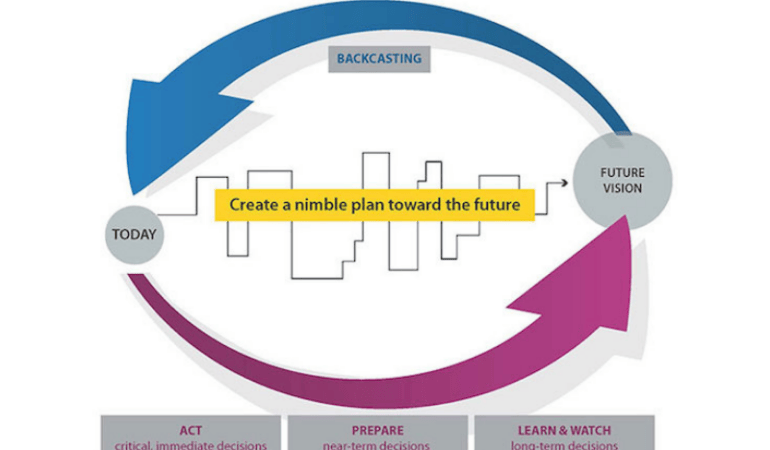Claudia López was elected mayor of Bogotá in October 2019, after campaigning as a Green Alliance candidate with a focus on climate change and other environmental issues. She is the city’s first female mayor and first openly gay mayor.
Mayor López was a senator of the Republic of Colombia from 2014 to 2018 and became a prominent figure in the fight against corruption; she was the vice presidential candidate for the Green Alliance party in the 2018 presidential election.
Prior to her political career, López worked as a journalist, researcher, and political analyst. She studied finance, public administration, and political science at the Universidad Externado de Colombia, and went on to earn advanced degrees in the United States: a master’s degree in public administration and urban policy from Columbia University and a Ph.D. in political science from Northwestern University.
López spoke with Senior Fellow Anthony Flint by video as she was on her way to the COP26 climate summit in Glasgow in the fall; they were joined by Martim Smolka, director of the Lincoln Institute’s Program on Latin America and the Caribbean.
Their discussion, edited for length and clarity, is the final installment of a special 75th anniversary Mayor’s Desk series, spotlighting the chief executives of cities that share a history with the Lincoln Institute. It is also available as a Land Matters podcast.
ANTHONY FLINT: Your victory suggests that residents are ready for serious action with regard to the environment and climate change. Do you feel you have a mandate, and what are your top priorities in terms of climate?
CLAUDIA LÓPEZ: Well, there is no doubt that I have a clear mandate from Bogotá’s people. During my campaign, I [made a public commitment] to environment and climate change issues. We have a deep social debt and a deep environmental debt that we have to pay. After the pandemic, the social debt will be harder to address than the environmental debt, because the pandemic has doubled unemployment and poverty in my city. On the other hand, on the environmental issues, I am still very optimistic that post-pandemic opportunities will increase.
We have to adapt, that’s our mandate. In the context of Colombia, we have three general issues. One of them, and the major contributor to climate change, is deforestation. This is an issue mainly for rural Colombia, and is by far the largest contributor of Colombia to the environmental crisis and the climate emergency. The second factor is fossil fuels. Transportation is the second largest contributor of Colombia to the climate emergency. The third is related to waste management. Bogotá has a great impact in transportation, and we have a great impact in waste management.
What are we doing? Migrating from a monodependent diesel bus system toward a multimodal system based on a metro, a regional train system, cable system, and also buses . . . [and] transforming waste management . . . into a recycling, green, circular economy, so that we transform waste into clean energy. Making the city greener. Hardening rural and green areas, that’s basically what building cities is about. What we need to do in the 21st century, I think, is the opposite. We need to take advantage of every public space that we have, making every effort not only to plant trees, not only to plant gardens, but to transform urban areas that we had before, gray areas that we had before, into green areas.
We’re lucky that we have the legal mandate to propose a new master plan, the POT [Plan de Ordenamiento Territorial]. We can include these changes and investments, not in a four-year-term government plan, but in a 14-year city plan. We are trying to take advantage of this moment.
AF: This year marks the centenary of the Colombian value capture tool contribución de valorización, or betterment contributions. What is your vision for building on that tradition?
CL: I think that’s critical. The most important financial tool we have for sustainable development is land value capture. In our POT, we are including not only the traditional betterment contribution, but also many other ways to use land value capture. [Ed. note: Betterment contributions are fees paid by property owners or developers to defray the cost of public improvements or services from which they benefit.]
We have at least seven different tools, financial tools, all related. Basically, we [determine] the value that’s going to be generated by a transformation of land use and we agree with the developer, so that the developers don’t pay us in cash, as in the betterment contribution, but pay [by] building the infrastructure and the urban and social equipment that new development will need.
This is not about having lovely maps with marvelous plans, this is about having the money to redistribute the cost and benefit of sharing and receiving. This is actually what I think urban planning is: making sure that either through public investments or through land value capture or through private investments, we ensure an equitable and sustainable share of the cost and benefits of building the city. That’s the role of the government, and that’s what we’re trying to achieve here.
AF: I’d like to turn now to the topic of crime, and ask you how has the problem of crime had an effect on the perception of the city and public space in the city in particular?
CL: It has a huge impact, of course. The more crime you have in public spaces, as a fact or as a perception, the less well-being you have as a city. What makes a city safer? The first thing I think is to make the city sustainable, and that means greener, and that means more equitable.
My top priority to make Bogotá safer is not to add cameras and technologies. It is to make sure that Bogotá has the capacity to provide fair and legal employment for our population, particularly for our youth. I think that the social roots of security are more important.
One thing that I’m very excited and very proud that we’re building into our POT and our land use development plan is that we are including criteria for women and caregivers as criteria for urban development in our city. If you can make a city safer for women, if you can make a city safer for kids, that will be a city safer for everyone.
Now the second thing, as important as transportation, infrastructure, and social infrastructure in the 21st century, is digital infrastructure. We are going to extend fibra óptica, the best, fastest internet, to every neighborhood in our city, to every school in our city. That’s crucial to make a more sustainable, more equitable, and safer city. At this moment in the post-pandemic time, we’re having a severe backlash in insecurity in our cities. It’s not only in Bogotá, it’s global. Unfortunately, higher unemployment and higher poverty always correlate with higher insecurity.
AF: What are the policies that are working to make life better in informal settlement, such as upgrading or infrastructure, and what in your view needs to change?
CL: We have at least three innovations included in our land use plan that I’m very proud of. As you know, in Latin America, roughly half of our cities has been built informally. This land use development plan is the first development plan that clearly assumes that, accepts that, and instead of doing a land use plan that is only useful for the formal city, for half of the city, this is a plan that recognizes that 45 percent of our city is informal.
It creates an urban norm, urban rules, and urban institution to help people improve their homes in the informal city, and to improve their neighborhoods. It is including all people within the land use development plan.
We have in Bogotá an institution called curaduría, which provides urban licensing and construction licenses. We are creating a public curaduría for the informal city. There’s no way that you can impose on half of the city an urban [standard] they don’t have any chance to meet. We [also] have the Plan Terrazas, which says, after we improve your first floor, after we improve it properly, then you can build your second floor, for example, or you can build some [space for] economic activity in your first floor. You will improve your housing, but you will [also] improve your income. For poor people, housing is not only the place they live, it’s also the place where they produce and they generate income.
The second thing that I think is very important is that we created this caring system, particularly thinking about women. Half of the economy is informal. It’s not formal jobs with pension funds and health insurance. They don’t have care when you are sick or when you are [older]. Who takes care of the sick and elderly? It’s the unpaid women who do that: 1.2 million women in Bogotá don’t have jobs, don’t have education, don’t have time for themselves because they are caregivers. For the first time in Bogotá, we are reserving land for social infrastructure to provide institutional health care. For children, for women, for elders, for people with disabilities, so that we can relieve and free up time for women, so they can access time to rest. They don’t have a free week ever in their life.
We’re trying to balance. I think the development in Bogotá has been incredibly unbalanced, with [much of] the advantage on the developer side. Of course, the developers need profitability, and we are trying to find the equilibrium point.
AF: The Lincoln Institute’s work in Latin America, including Colombia, has been such a big part of our global reach. As we celebrate our 75th anniversary, could you reflect on how that presence has been helpful in the region?
I think it has been incredibly helpful really. I [have worked] with the United Nations and with other organizations, and different governments in Latin America. There’s always a specialist or academic person or professional person who has been trained by the Lincoln Institute. There’s a huge network of people thinking, researching, innovating, putting out these debates, which is incredibly important.
In my own experience, I cannot tell you how useful all the things that you taught me have been, on land value capture, for example, on land use development, on being aware of how land and urban value is created. Why this is a publicly created thing, and why we need to use all the instruments we have to capture that value and to redistribute it in a more equitable way to everybody in the city. To Martim Smolka, Maria Mercedes, and everybody in the Lincoln Institute, I cannot be more grateful, and the network of professionals and trainees and academic people and the research that they support on this topic, particularly in Latin America, is incredibly useful.
This interview is also available as an episode of the Land Matters podcast.
Anthony Flint is a senior fellow at the Lincoln Institute, host of the Land Matters podcast, and a contributing editor to Land Lines.
Image: Mayor López speaks at a climate event at the COP26 summit in Glasgow. Credit: Office of the Mayor.






